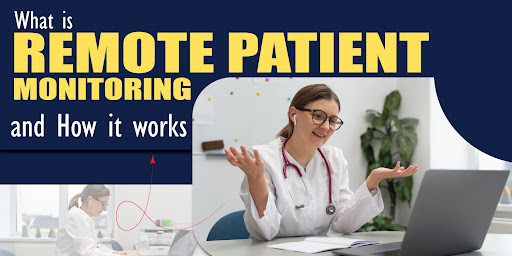What is Remote Patient Monitoring, and How it works?
Now the world has changed. This world is now tech-oriented. Everything is processed through technologies. But, the world did not realize it two years back till the pandemic of COVID-19 came. This pandemic has changed the lifestyle of the whole world. During the pandemic, many countries were under lockdown. No one is allowed to go outside of their homes for anything.
During that crucial time, technology became a medium that helped people with many things like online grocery shopping, communicating with each other, entertainment, health-related issues, etc. Health issues were very serious at that time. People could not understand what to do or not, but with the help of technology, millions of critical situations in healthcare were under control.
Some experts have seen that over the last few years, the adoption of remote patient monitoring devices has grown significantly, and it is expected that this trend will continue to expand at a rate of roughly 12.5% over the next ten years. Due to the high population, costly treatments, healthcare in remote areas, etc., remote patient monitoring appears to have a bright future. You don’t have to go to any clinics or hospitals for treatment and bear the heavy expenses of treatment. You can receive healthcare services from your home with the help of remote patient monitoring devices. In this blog, we will discuss what remote patient monitoring is, its benefits, and how it works. For that, you have to stay with us and read this blog.
What is Remote Patient Monitoring?
The term ‘Remote patient monitoring’ or RPM has described the process of remotely monitoring a patient’s health data using medical monitoring equipment. These types of equipment for patient monitoring transfer health information data from a patient to healthcare professionals. After that, healthcare professionals review it and monitor the patient’s health remotely. Healthcare professionals can monitor a patient’s health using RPM systems and technology by electronically receiving health data from the patient’s health monitoring devices. Based on this data, they can observe changes and suggest suggestions. Many of you must be confused by remote patient monitoring with Telehealth or telemedicine. Let’s discuss it and see what are the differences between them.
Remote patient monitoring v/s Telehealth
Remote patient monitoring and telemedicine are the subdivision of Telehealth. But it does not mean that telemedicine and remote patient monitoring are the same. They are different from each other and subdivisions of Telehealth. Let’s start with Telehealth. Telehealth is the utilization of digital information and telecommunications technologies to assist in long-distance clinical treatment, health administration, education related to patients and professionals, public health, etc. Where the usage of a gadget for communication between doctors and patients away from the doctor’s organization is known as remote patient monitoring. Telehealth uses many technologies like emails, phones, text, video calls, and remote patient monitoring devices to communicate with patients and collect their health-related data to analyze their health issues.
Let’s see some benefits of remote patient monitoring.
Benefits of remote patient monitoring
The followings are the benefits of remote patient monitoring-
1. Enhances the use of data in clinical decision-making
RPM helps practitioners by enhancing their clinical understanding of patients’ conditions between doctor’s visits and providing them with tools to inform proactive care delivery.
2. Helps patients conform to their care plans and enhance self-management
Patients who use remote patient monitoring gain access to quick, simple, condition-specific solutions to manage their disease.
3. lowering of healthcare costs for patients and professionals
RPM reduces the cost of healthcare in hospitals. In hospitals, too many services are available, which you have to pay for. But, with the help of RPM, you don’t have to pay for these services. It automatically reduces the cost of your healthcare.
4. Decreases patient costs and increases output at work
If you are taking healthcare services through RPM, then you don’t have to go to the hospital. It means you don’t have to bear expenses like traveling, hotels, food, parking, etc.
5. Enhances patient access to care
RPM is beneficial for those who don’t have good hospitals or clinics nearby. You can connect and make appointments with a specialist for your health issues. It reduces access barriers. The rural areas will take more advantage of it.
6. Increases patient involvement
As it gives the patient tools to help them understand their health, remote patient monitoring is an excellent patient involvement method. Positive health outcomes are more likely to occur when a patient is aware of their disease, the specific treatment plan of the disease, and their role in enhancing their health. Convenient access to health education resources raises the level of involvement even further. Apart from the above benefits, there are many more benefits of RPM. Now it’s time to see how remote patient monitoring works.
How does remote patient monitoring work?
Now, you know what remote patient monitoring is and how it differs from Telehealth. But, you might have a question in your mind that how remote patient monitoring works. Let’s see.
The followings are the steps that show you how it works-
1. Collection of health data
Activating the RPM device is the first step to setting up a remote patient monitoring system. With the help of Bluetooth in the device, they communicate with patients and collect data related to their health. If these devices have advanced technologies, the devices can gather a wide range of data like blood pressure, heart rate, oxygen level, etc. These devices are most frequently via mobile apps for smartphones that are specifically designed for remote patient monitoring capturing patient data and transmitting it to healthcare professionals. FDA has approved the following types of devices-
-
Spirometers
-
Cardiac monitors
-
Apnea monitors
-
Electronics thermometers
-
Blood pressure monitors
-
Electrocardiographs
-
Breathing Frequency Monitors
-
Audiometers
-
Electronics Stethoscopes
-
Oximeters
2. Transmission health data
After collecting health data from patients with the help of RPM devices, all the data will transfer to respective healthcare providers. These data will be transmitted with the help of email, phone, text, Internet, etc.
3. Evaluation and Notification of Health Data
Under this step, all the data gets evaluated by doctors that are received from RPM devices to healthcare professionals. The upper and lower (threshold) values established by a doctor are then compared to the vital sign data either automatically or manually. When the threshold value is exceeded, the RPM system at the healthcare facility generates a notification, which informs a doctor of an aberrant scenario and generates a warning message. This doctor notification may come in the form of an email, SMS, or in-app notification.
4. Taking action
After the notification is issued, doctors will alert the emergency room, and the patient will visit the emergency room for medical emergencies. The appropriate authorities are informed, and quick aid is given if the patient’s health information indicates that they need immediate medical attention. The doctor can communicate by phone, email, or notification.
Conclusion
In this blog, we discussed remote patient monitoring and how it works. We also mentioned how RPM is different from Telehealth and the benefits of remote patient monitoring. We hope that the blog will be useful for you.
Share this content:














Post Comment